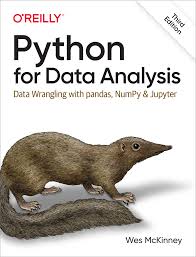Description
Python for Data Analysis
✅ Key Features:
-
Comprehensive Coverage of Data Analysis Tools:
-
Focuses on essential Python libraries like Pandas, NumPy, and IPython (now part of Jupyter), which are crucial for handling, cleaning, and analyzing data.
-
Covers the fundamentals of each tool and demonstrates how to use them together to solve real-world data analysis problems.
-
-
Practical, Hands-On Approach:
-
The book provides practical examples and case studies that guide readers through the process of data wrangling, manipulation, and analysis.
-
Emphasizes hands-on learning with detailed Python code snippets, making it ideal for readers who learn best through practice.
-
-
Data Wrangling and Cleaning:
-
One of the key focuses is on data wrangling—how to clean, reshape, and prepare raw data for analysis.
-
Covers techniques for handling missing data, merging datasets, pivoting, and grouping data, which are essential tasks in any data analysis project.
-
-
Mastering Pandas and NumPy:
-
Deep dive into Pandas, the library that allows for efficient manipulation of large datasets, including DataFrame and Series structures.
-
Covers NumPy, the library for numerical operations in Python, explaining how to use it to perform efficient array-based computations and matrix manipulations.
-
-
Efficient Data Processing:
-
Discusses techniques for processing large datasets efficiently in Python, including vectorized operations and parallel processing.
-
Teaches how to optimize performance when working with big data by utilizing the full power of Pandas and NumPy.
-
-
Data Visualization:
-
Introduces basic data visualization techniques using Matplotlib, another important library for creating static, animated, and interactive plots.
-
Shows how to integrate visualizations with the data analysis process to communicate insights effectively.
-
-
Advanced Data Handling:
-
Covers more advanced topics such as time series data, categorical data, regression analysis, and working with hierarchical data.
-
Demonstrates how to work with real-world data formats, including CSV files, Excel spreadsheets, and SQL databases.
-
-
IPython (Jupyter) Integration:
-
Explores the use of IPython (now known as Jupyter) as a tool for interactive data analysis.
-
Discusses how to use the IPython shell for quick experimentation and how to organize and share analyses through Jupyter notebooks.
-
-
Best Practices and Performance:
-
The book emphasizes best practices for writing clean, efficient, and maintainable code when working with data in Python.
-
Provides guidance on how to structure your data analysis code and troubleshoot performance bottlenecks.
-
-
Updated Content (2nd Edition):
-
The second edition includes updates to reflect changes in the Python ecosystem, particularly newer versions of Pandas and NumPy, and how to use them effectively.
-
Updated with modern tools and techniques, making it relevant for current data analysis workflows.
-



Reviews
There are no reviews yet.